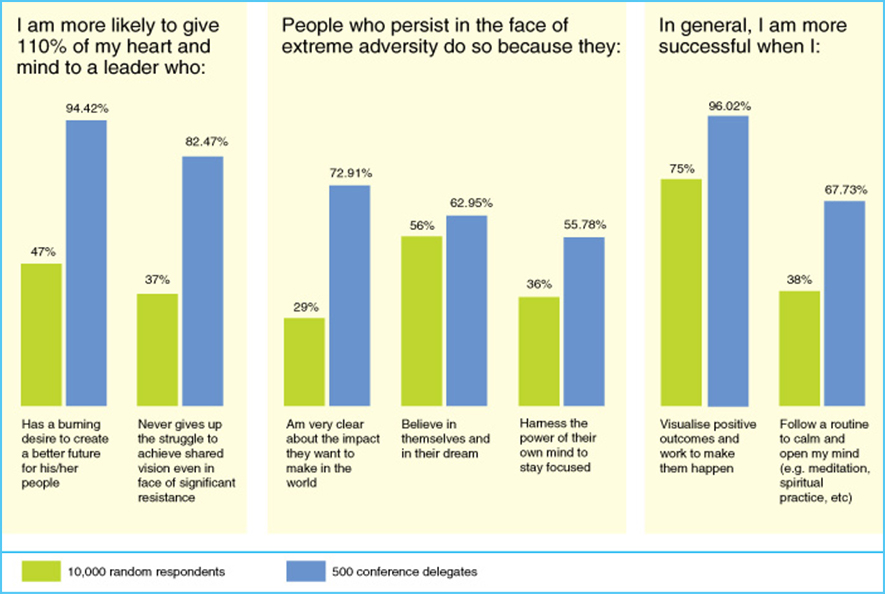Quantum mechanics, spirituality & leadership

Lãnh đạo & Quản lý
455 tuần trước — 30 phút đọc
For two decades, I’ve puzzled over a fundamental paradox: on the one hand, companies globally spend billions each year on leadership development, yet on the other hand most continue to report an acute shortage of good leaders within their ranks. After much research and practical experience, I am becoming increasingly convinced that we may be looking for leadership advice in too narrow a space. Instead of just management and psychology books (and training programs) produced largely by business school professors, the secret of great leadership might lie at the confluence of quantum mechanics, neuroscience, biology and spirituality.
Let’s first dispel some common misconceptions about leadership, then consider an alternative point of view. I begin with two quick leadership stories, one each from Japan and the US.
The fall and rise of Honda
Soichiro Honda was born in 1906 and grew up helping his father repair bicycles in Komyo village (now called Tenryu City) Japan. While still at engineering school, he started a workshop with the intention of developing a piston ring for sale to Toyota. He worked day and night to produce what he believed to be the perfect design, often sleeping on the workshop floor. Facing considerable financial hardship during this period, he had to sell his wife’s jewelry to raise capital. When he finally completed his design and took the finished piston ring to Toyota, he was told that the work was not up to their standards. While a bit disappointed, he believed strongly in his idea and refused to give up. Amidst ridicule from fellow engineering students and teachers alike, Honda toiled for a further two years before finally winning a contract from Toyota. By this time Japan was gearing up for war and he found it increasingly difficult to find building materials for his factory for manufacturing the piston rings. Yet he persevered, finding a new way of making concrete, and finished building the factory.
Sadly, this was not the end of Honda’s troubles. The factory he had worked so hard to build was bombed twice during the war, and steel became unavailable. While most would have relented at this time, Honda stayed focused on his dream and found a way around the steel problem. He started collecting gasoline cans discarded by US fighters to help regenerate his factory. As he started rebuilding, a massive earthquake destroyed it completely. This setback would have quelled the will of the most ardent of self-believers, but Honda was in no mood to throw in the towel even then. He forged ahead. After the war, he found a way of attaching a small engine onto his bicycle, and found that people were fascinated by this strange new idea. By this time however he had no financial means to fund mass production. Rather than giving up, he wrote to 18,000 bicycle shop owners asking them to invest in his idea. With the numerous small investments he received, and after several redesigns, he finally came up with “Super Cub” which went on to become an overnight success.
By 1963 Honda was the top-selling motorcycle brand in the US, and the company now employs over a 100,000 employees worldwide.
The magic of Walt Disney
Walter Disney is well known for his colossal legacy. Less known are the struggles, trials and tribulations he went through before Disney Studios and Disneyland became household names. Trouble began early when, one by one his brothers ran away from home due to difficult relationships with their father. Eager to follow in their footsteps, Disney lied about his age to enter the army but was rejected. His eventual ticket out was a job with the Red Cross as an ambulance driver in France. He returned home at age 19 and told his parents he wanted to be an artist. His father would hear none of it, so the young Disney moved to Kansas City to work at the Gray Advertising Company for $50 a month. However, only a few months later, he was let go. Jobless and penniless again, he then started the Laugh-O-Gram company with a friend. Though the cartoons they created were somewhat successful, distributors were more interested in acquiring the work than paying for it. At age 22 Disney put Laugh-O-Gram up for bankruptcy.
The next few years were tough, and at times Disney barely had enough money for food. Eventually when he could save up enough for a trip, Walt joined his brother Roy in Hollywood where he launched his next creation, the cartoon character Oswald the Rabbit. This venture established Disney as a leading cartoonist in the country. But when he fought his distributors for more money so that he could perfect the art and technology of creating cartoons, they were uninterested. When he threatened to take Oswald elsewhere, he learned that Oswald the Rabbit, and all the artists in his studio belonged to the distributor, not him. Thanks to some fine print he had not paid attention to, his creation and staff were taken from right under his nose.
After going through a rough patch (which he called “one heck of a breakdown”), Disney created Mickey Mouse, which finally brought him lasting success. He still had many critics and naysayers: some told him Snow White was terrible, and advised not to go ahead with the project. He ignored them and persisted, only to prove that it was a huge hit. Later when he was working on his pet Disneyland Park project, most well-wishers told him it was a bad idea and discouraged him from pursuing it. They were certain it would bankrupt Walt Disney Studios. Again, he stuck to his vision and completed the park. The franchise continues to expand globally to this day, with the Florida resort alone receiving 52.5 million visitors annually.
Leadership myths & reality
To most people, someone in a powerful position of authority is automatically a leader. Consequently, leadership is seen simply as the ability to get people to do what the ‘leader’ wants them to do, often with the help of the powerful position he occupies. By this logic, did Honda and Disney become leaders only after they created their empires? Did they toil endlessly only to acquire the authority to get people to do what they wanted them to do? Yes, it is true that a leader must convince others to follow him or her, but is that the main purpose of leadership? If you answered the three questions with a ‘no,’ then what is good leadership after all?
We find that all great leaders have two things in common:
1. A burning desire to create a better future
2. The ability to stay the course even in the face of the most formidable of resistance
It is the strength of these two elements that attracts willing followers to them, rather than their position of authority. Gandhi and Mandela in the political/social arena, and Howard Schultz, Steve Jobs, Jack Ma and many others in the business arena were considered great leaders not because of their position, authority, appearance, personality, management techniques or heredity, but because they created better futures for people around them. And no matter how tough the going got, they never gave up.
Soichiro Honda and Walt Disney were no different. Despite a rough childhood, early bankruptcy, loss of his own creations and staff, and a slew of critics who called his biggest project – the Disneyland Park – Walt’s Folly, Disney never gave up. As he himself said, “All the adversity and troubles I’ve had in my life have strengthened me…. You may not realize it when it happens, but sometimes a kick in the teeth may be the best thing for you.” Despite all his early failures and setbacks, Honda too never gave up. His oft-cited quote says it all: “Success is 99% failure.”
Another common misstep in leadership studies is to solely consider the experiences and views of followers. If you ask employees what more they want from their bosses, the average person wants more compassion, understanding, fairness etc. While there is nothing wrong with this list of attributes, few followers identify/emphasize the real leadership mission – creating a better future. Unfortunately huge investments are made in employee engagement surveys and subsequent training programs to make bosses more like what their followers want them to be. Although leaders certainly need to understand employee engagement drivers, that is merely one aspect of leadership. Before focusing on employees, the leader must dream up the better future he or she wants to create.
However, as is evident from the Honda and Disney stories, viewing leadership in terms of creating a better future raises a major issue – few people see or recognize the leader’s vision of a better future early enough, or realize that one is even needed. For instance, before the iPod, who would have thought that it was possible to listen to music on a hard drive? Yet, Jobs and Apple went on to completely revolutionize and democratize the music industry. If one had asked Sony Walkman users at that time to describe how their on-the-go music experience could be improved, how likely is it that anyone would have asked for a pocket sized hard drive? Before Gandhi showed the world a non-violent way to fight, the only known responses to colonialism were either submission or violent uprising. Before Jack Ma created Alibaba.com, the small and medium sized businesses in China had no collective power against big buyers like Walmart.
The point is this: simply asking people what they want from their leaders (and creating leadership programs on the basis thereof) is unlikely to create better leaders because, in a sense, people don’t know what they don’t know. Leadership is about stepping into the unknown, and creating conditions that don’t yet exist. Leaders envision a better future for their people that they (the people) don’t often initially recognize or understand. As a consequence, a leader faces huge resistance along the way. Leadership is not a popularity contest. If anything, it might be the opposite. As Mahatma Gandhi rightly once said: “First they ignore you, then they laugh at you, then they fight you, then you win.”
Staying the course in the face of resistance, unpopularity and loneliness requires tremendous inner strength. This strength is the fuel that keeps real leaders from giving up, and we call it Leadership Energy. Few are able to uncover the intrinsic leadership energy to prevail in the game of creating a better future.
Leadership energy – The life force
The real question of leadership is this: What are the sources of energy that allow true leaders to persevere? After much thought, research and personal experience spanning more than two decades of observing good and bad leaders all across the world, I view leadership energy as made up of three things:
1. Finding purpose – The better future you want to create
2. Defining values – The personal moral principles you will never compromise under any circumstances
3. Harnessing the mind – Using the power of mind to never stop living a life of purpose and values
The first two I’ve discussed in detail in my book Too Many Bosses, Too Few Leaders (Simon & Schuster, 2011). The key idea of the book was simple: when one feels down and out, the only thing that makes her get up again and fight the fight is clarity of purpose and values. But very few people manage to develop really deep conviction in their purpose and values, and therefore are devoid of leadership energy. So while there is no shortage of powerful bosses around, very few are real leaders.
Here I want to focus more on the less intuitive third source of leadership energy – the human mind. And this is where quantum mechanics, neuroscience, biology and spirituality come in.
The Third Source – Harnessing the power of mind
The Shaolin monks of China routinely demonstrate amazing and unbelievable feats of human strength, like breaking bars of steel with their heads, or chopping stones into pieces with their bare hands. If you haven’t seen them in action, just search Youtube for Shaolin Monks or Shaolin Kungfu, and take your pick. After you watch them in action, ask yourself this: how much of their ability derives from physical versus mental strength? I asked a Chinese audience in Shanghai recently, and their guess was 80-90% mental. I don’t know the exact answer myself, but the power of focusing the mind seems to have a lot to do with their abilities.
Now consider the following questions:
• What if we could communicate with each other over great distances without using the internet or telephony, just by beaming our thoughts?
• What if we could acquire knowledge without reading or listening to someone speak?
• What if we could alter physical reality with just our thoughts?
• What if we could affect our own genes with our thoughts?
• And what if we could break steel or stone just by concentrating our mental energy on it?
These questions will sound completely crazy to most people, except if you believe in ancient metaphysics and spirituality, which have always claimed that everything in the Universe – people and things – are connected through an energy field, and we humans are not unique individuals observing the Universe from the outside.
As a result of such connectivity, ancient metaphysics also claims that the human thoughts and intentions can travel through the energy field, and have the power to influence reality. Hinduism, Buddhism, Sufi-ism and other philosophies have rich texts describing the metaphysical view of the world. In essence, they all say the same thing: through deep meditation and mental focus, the human being can influence reality with his thoughts. While the practice of these philosophies has survived thousands of years in many pockets of the world, it is not the most widely accepted medium with which to understand and interpret the world.
For lack of sufficient empirical evidence, modern physics evolved to squarely reject any and all ancient metaphysical claims of universal connectivity and the power of human consciousness. Instead, Newtonian physics became the widely accepted lens to examine and understand the world. In recent years however, quantum mechanics, neuroscience and biology are proving that ancient metaphysics might have been right all along, and that everything around us is indeed connected. In other words, the human mind may indeed have more power to influence reality than we fully understand.
Consider the following strands of evidence.
Spooky action at a distance
Metaphysical claims of “oneness” – that everything in the Universe is connected – are difficult to believe in our everyday physical world where living beings and non-living objects seem clearly separate and distinct from one another. This claim of universal connectivity forms much of the basis for the mind’s ability to influence reality. If the claim is indeed as untrue as it seems, we cannot proceed further to dig for proof of the connection between human thought and the physical world. Perhaps this is why metaphysics lost out to Newtonian physics. However, since the 1930s, research in the field of quantum entanglement has suggested that at the sub-atomic level, everything might indeed be connected. According to entanglement theory, a pair of particles (of the matter that everything and everyone is made up of) once connected to each other, remain connected forever. Actions performed on one affect the other, even when separated by great distances. Unable to make sense of this phenomenon, Einstein called this “spooky action at a distance.” Subsequent research by scientists like David Bohm and John Stuart Bell provides evidence that quantum particles indeed remain connected over vast distances.
Does quantum mechanics (or quantum physics) lend credibility to ancient metaphysical claims of universal connectivity? Might human DNA, thought and emotions be able to impact reality after all? Consider one more piece of research, conducted by Russian quantum biologist Dr. Vladimir Poponin and his colleague Peter Gariaev. Through a series of experiments, they tried to prove that human DNA has a direct effect on the physical world through a field of energy that connects the two. They first recorded the presence of photons in an otherwise empty tube, and noted that the photons were scattered randomly across the tube. Next, they dropped a sample of human DNA in the tube, and found that the photons arranged themselves distinctly in a pattern. Finally, when they removed the DNA from the tube, they expected the photons to go back to being randomly scattered, but to their surprise they found that the photons remained in a pattern. This behavior of photons in the presence of DNA has come to be known as The DNA Phantom Effect. Other research (beyond the scope of this article) also points to the strong possibility that human emotions can affect DNA, even at a distance.
Mind over matter
Might the above new knowledge in the realm of quantum behavior also apply to our everyday physical world? Might we be able to impact physical outcomes with our thoughts? Last year, I met Dean Radin, Senior Scientist at the Institute of Noetic Sciences (www.ions.org) in Petaluma CA. Radin has devoted much of his career researching the scientific basis of Psychokinesis and other psychic phenomenon. In 1989, while Radin and Diane Ferrari were at Princeton University, they used meta-analysis to assess the combined evidence of Psychokinesis effects on dice throw experiments. They found 73 published studies between 1935 and 1987 in which about 2500 subjects had attempted to influence 2.6 million dice throws with their thoughts over 148 experiments. After taking into account and adjusting for several possible design flaws in the experiments, they found strong evidence that intention had a positive effect on the dice throws. Through rigorous statistical analysis, they calculated that the odds of favorable results being purely due to chance were over a billion to one. It was clear that human intention – the only stimulus applied – was responsible for the outcomes.
In 1997 engineer Robert Jahn and his colleagues at the Princeton Engineering Anomalies Research Laboratory (PEAR Lab) published results of a similar 12 year study using random number generators (RNGs). 100 volunteers tried to mentally influence the RNG machines to churn out more ones or zeros. The study again showed some positive effects, and calculations revealed the odds of this happening purely by chance of 35 trillion to 1. Similar research has since been conducted in other countries. Radin’s books – The Conscious Universe, Entangled Minds, and Supernormal provide detailed evidence for those interested in exploring further. In Supernormal, he discusses the scientific basis of Yogic abilities (known as Siddhi’s) like clairvoyance and remote viewing.
Mind over body
Most parents intuitively try to teach their children about the power of positive thinking. Now, there’s emerging scientific evidence supporting the claim. For instance, in his ground breaking book, The Biology of Belief, Bruce Lipton shows how the old belief that we are controlled by our genes might be completely wrong. A cellular biologist at the University of Wisconsin, Lipton spent much of his career studying and cloning human muscle cells. He concluded after decades of research that our perceptions and beliefs select our genes and therefore our behavior. In his book, he skillfully shows the molecular process of how our beliefs actually attach to our genes and therefore impact our destiny.
Similarly, new research on Neuroplasticity – the brain’s ability to be plastic, or to change itself – now suggests that we can re-wire the brain through visualization and practice to form new habits and improve performance radically. Until recently it was believed that the brain has “centers” for different activities, and if a particular activity center was damaged, there was no way to replicate that activity. It turns out that even if parts of the brain are severely damaged, one can re-wire other parts of the brain to take over the functions of the damaged parts. In The Brain That Changes Itself, Norman Doidge chronicles several successful examples of such Neuroplasticity.
Lots of other research, for example the relatively recent discovery of the presence of mirror neurons in the human brain, points to the same thing: The mind may have much more power to influence the body than imagined before. Mirror Neurons are a subset of our motor command neurons. Motor command neurons enable us to perform bodily functions involving motion. In other words, motor command neurons fire up when we execute any function involving motion, such as raising our hand. The interesting thing about mirror neurons is that they fire even when we look at someone else performing a motion function. Just think about what happens to your body muscles and emotions while you are watching an intense tackle in a football game in a stadium where your favorite team is playing. Thanks to your mirror neurons, your muscles get tense, and you get completely involved in the tackle, as if you are playing yourself. The brain seems to think that we are performing the function even while we simply watch someone else perform the function.
Coaches now routinely use the power of repeated visualization to help athletes surpass their personal best. This is based on the growing understanding that repeated intense visualization – through the use of mirror neurons – creates new neural pathways that actually help in executing performance at a higher level. In other words, intense visualization, which is nothing but concentrated thinking and imagination, trains the brain (and therefore our body) to perform at higher levels. The discovery of mirror neurons finally explains how profoundly human minds are connected. It also provides the science behind what we’ve always been told by generations before us – think positive, and positive things will happen.
A new paradigm for leadership development
The science behind the various phenomena outlined above is still emerging, and is sometimes referred to as frontier science. While the evidence is growing, it is by no means definitive. I leave it to the reader to decide how much to believe or otherwise. In my research on successful leadership however, one theme seems to recur with remarkable regularity: The strength of your beliefs and convictions has a big part in determining whether or not you might succeed in creating a better future. In other words, if you can believe it, chances are you can do it. Honda, Disney, Gandhi, Schultz and all the other leaders mentioned earlier seem to have adhered strongly to their beliefs.
So what does frontier science and spirituality have to do with leadership ability? Lots if you consider this question: What if business leaders, political leaders, or even self-leaders for that matter, were able to tap into some of the mental energy harnessed by the Shaolin monks? Over the last 3 years, my colleagues and I at the Iclif Leadership & Governance Center have introduced the concepts of leadership energy (clarity or purpose and values, and using the power of mind) into our work with client organizations. We’ve proceeded with caution, knowing how often new ideas and paradigms meet with initial skepticism and resistance. Only after consistent efforts to inform and educate, does the new knowledge get accepted. Keeping in mind the reluctance of the average business executive to venture into this seemingly “unknown” realm, we decided to tread carefully. Slowly but surely, bit by bit, we’ve introduced elements of leadership energy in our executive education curriculum. We’ve included the emerging evidence that science is now re-discovering the foundational principles of eastern metaphysics. We pointed out that those who engage in a regular meditative or other mind stilling routines are more likely and able to use the power of their minds in influencing reality. We’ve introduced participants to the latest scientific research about the positive effects of meditation on the brain. With each program, we’ve pushed the envelope a little further. To our pleasant surprise, we’ve found that rather than being skeptical, our audiences over the last three years have shown remarkable interest in and openness to the concepts discussed here. We learned that once we were able to create a safe environment, most people stepped out of the closet and shared deeply personal experiences about universal connectivity and the power of mind. It has become clear that while it may not be conventional to think about leadership along the lines discussed here, it is very much possible to broaden perspectives with a bit of context setting, exposure and education.
Consider the results of a recent survey we completed in December 2013. We surveyed 10,000 randomly selected professionals from 27 countries and asked them three questions to find out if they agreed with the key elements of leadership presented here and as summarized below.
Leadership is not a position, title or role – it is making the choice of striving hard to create a better future:
- Creating a better future involves facing tremendous resistance all along the way – leadership is often a thankless, lonely and tireless job, with no guarantee of success
- Non-leaders give up in the face of such resistance and low odds of success
- The only way to overcome resistance and stay the course (and therefore be a leader) is to find a deep reservoir of personal leadership energy
- Leadership is the art of harnessing human energy towards the creation of a better future
- The two primary sources of leadership energy are ‘clarity of purpose,’ and ‘clarity of values.’
- The most powerful leaders in history also seem to use a third source as the power of the human mind
- Those who engage in a regular routine of stilling and calming their mind (as opposed to constantly multi-tasking) are more likely to succeed at using the power of their mind to influence reality
Next, we surveyed 500 executives from across Asia who had participated in a two-day conference on Leadership Energy and its three sources, and asked them the same questions. Details of the conference can be found at www.iclif.org/lesa. Comparing the data from the 10,000 uninitiated respondents with the responses from the 500 conference delegates, we were blown away. As expected, to the 10,000 uninitiated, the paradigm of leadership outlined above did not make intuitive sense. But in just two days of targeted exposure, the 500 conference delegates FULLY believed in the concepts of leadership energy, including the importance of the less intuitive third source – the power of the human mind. The chart below shows some of the key difference in responses between the two groups of respondents. The bars represent the percentage of respondents who included the said attribute in their top 3 choices while answering the question. Please see the below infographic for detailed data and survey methodology.
To account for the immediacy effect on our 500 conference delegates, we conducted another survey and asked participants who had attended one of our programmes up to 2 years ago if they benefitted in any way, and if they had retained any of the learning. The results of this survey were also encouraging. A full 6-24 months after attending, 95% of respondents said they found the knowledge still useful. 100% reported having made some behavior/ attitude change, and 85% reported having made profound positive changes in both personal and professional life. I have seen many such studies over the course of my nearly two decades in the leadership development field, but never had I seen such positive results until now.
The science & spirituality of leadership
While uncovering the three sources of leadership energy may not be the holy grail of leadership development, one thing is clear, there is more to the power of the human mind than is widely understood. As science and spirituality start to converge, the evidence for the universal connectivity of people and things is growing by the day. Our ongoing interactions with great leaders continue to confirm that those who prevail over stubborn resistance to create a better future, believe strongly in their purpose and values, and often also use the power of their mind to influence reality.
So, what is your purpose? What better future will you create, and for whom? What are your deeply held values that you will never compromise, no matter what? And, are you using the full power of your mind?
Article source: http://iclif.org/articles/quantum-mechanics-spirituality-leadership/
Disclaimer: The views and opinions expressed in this article are those of the author and do not necessarily reflect the views, official policy or position of GlobalLinker.

Xem trang cá nhân của Rajeev
Các bài viết khác được viết bởi Rajeev Peshawaria
Five denials of the human brain
430 tuần trước
Đọc nhiều nhất trong tuần này
Xu hướng
Get Efficient at Taking Decisions
Lãnh đạo & Quản lý 25 tuần trước
The Art & Science of People Pleasing in Retail
Bán lẻ 28 tuần trước
Khởi nghiệp 28 tuần trước















Bình luận
Chia sẻ nội dung này
Vui lòng Đăng nhập hoặc Đăng ký để tham gia bình luận